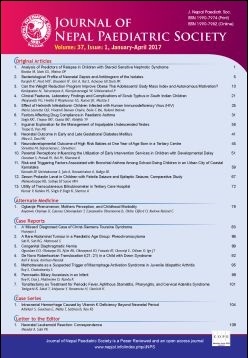Inguinal Exploration for the Management of Impalpable Undescended Testes
DOI:
https://doi.org/10.3126/jnps.v37i1.16917Keywords:
Impalpable testes, OrchidopexyAbstract
Introduction: The primary goal of surgical intervention with an impalpable testis is to locate and reposition the gonad. There has been much debate in the management of impalpable undescended testes. Many centres still advocate the role of open inguinal exploration in impalpable testes.
Materials and methods: This retrospective study included 35 male patients. The clinical notes were reviewed for details of age at operation, side, location and condition of testes intraoperatively and the type of operation performed. Standard approach of inguinal explorations was performed under general anaesthesia. Follow up in first week and after 3 months was done.
Results: 25(71.42%) impalpable testes were in left side, 9(25.71%) were on right side and 1(2.85%) was bilateral. At exploration 17(47.22%) were intracanalicular, nine (25%) were intraabdominal with seven low and two high,49(11.11%) were scrotal and six (16.66%) were absent, seven (41.17%) canalicular testes underwent orchidopexy and 10(58.22%) underwent gonadectomy for atrophied testes. Seven (77.77%) low abdominal testes were brought down to scrotum and two (22.22%) high abdominal were brought down to lower inguinal area as a first stage surgery. All 4(100%) scrotal testes were atrophied and gonadectomy performed. Six patients were diagnosed anorchia, 14 (87.5%) of impalpable testes that underwent orchidopexy were in a follow up with excellent results. One high first stage orchidopexy and another canalicular testes were found to have atrophied who did orchidectomy in follow-up.
Conclusion: Inguinal exploration is a safe, reliable and successful surgical procedure for the management of impalpable testes including intraabdominal testes without procedure related complications.
Downloads
Downloads
Published
How to Cite
Issue
Section
License
Authors who publish with this journal agree to the following terms:
Authors retain copyright and grant the journal right of first publication with the work simultaneously licensed under a Creative Commons Attribution License that allows others to share the work with an acknowledgement of the work's authorship and initial publication in this journal.
Authors are able to enter into separate, additional contractual arrangements for the non-exclusive distribution of the journal's published version of the work (e.g., post it to an institutional repository or publish it in a book), with an acknowledgement of its initial publication in this journal.
Authors are permitted and encouraged to post their work online (e.g., in institutional repositories or on their website) prior to and during the submission process, as it can lead to productive exchanges, as well as earlier and greater citation of published work (See The Effect of Open Access).



